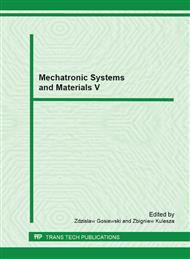[1]
W.H. Gourdin, Correlation between the ultimate elongations of rapidly expanding rings and stretching metal jets, Shock-Wave and High-Strain-Rate Phenomena, Eds. L.E. Murr, K.P. Staudhammer, M.A. Meyers, Marcel Dekker, Inc., New York-Basel-Hang Kong (1992).
DOI: 10.21236/ada248665
Google Scholar
[2]
J. Janiszewski, E. Włodarczyk, The selection of shaped charge liner material by using expanding ring technique, Proceedings of 11th International Scientific Conference - Armament and Technics of Land Forces, Liptovský Mikuláš (2005), p.38¸45.
Google Scholar
[3]
W.P. Walters, J.A. Zukas, Fundamentals of shaped charges, John Wiley and Sons, New York-Chichester-Brisbane-Toronto-Singapore (1989).
Google Scholar
[4]
D. Grady, Fragmentation of Rings and Shells, Springer-Verlag Beriln Heidelberg (2006).
Google Scholar
[5]
GT. Gray III, ASM Handbook: Mechanical Testing and Evaluation, vol. 8. In: Kuhn H, Medlin D, editors. Materials Park, OH: ASM International; (2000), p.939¸1270.
Google Scholar
[6]
A. Tamhane, M.M. Altynova, G.S. Daehn, Effect of sample size on ductility in electromagnetic expansion, Scripta Materialia, Vol. (34), No. 8 (1996), p.1345¸1350.
DOI: 10.1016/1359-6462(95)00672-9
Google Scholar
[7]
H. Zhang , K. Ravi-Chandar, On the dynamics of necking and fragmentation—II. Effect of material properties, geometrical constraints and absolute size, Int J Fract (2008) 150: 3¸36.
DOI: 10.1007/s10704-008-9233-3
Google Scholar
[8]
M. Altynova, X. Hu, G.S. Daehn, Increased ductility in high velocity electromagnetic ring expansion, Metall Mater Trans A 27A: (1996), p.1837¸1844.
DOI: 10.1007/bf02651933
Google Scholar
[9]
J. Janiszewski, Ductility of selected metals under electromagnetic ring test loading conditions, International Journal of Solids and Structures, 49, (2012), p.1001¸1008.
DOI: 10.1016/j.ijsolstr.2012.01.005
Google Scholar
[10]
D.E. Grady, D.A. Benson, Fragmentation of metal Rings by Electromagnetic Loading, Experimental Mechanics, 23, 1983, p.393¸400.
DOI: 10.1007/bf02330054
Google Scholar
[11]
W.H. Gourdin, Analysis and assessment of electromagnetic ring expansion as a high-strain-rate test, J. Appl. Phys., 65, 2, (1989), p.411¸422.
DOI: 10.1063/1.343121
Google Scholar
[12]
J. Janiszewski, W. Pichola, Development of Electromagnetic Ring Expansion Apparatus for High-Strain-Rate Test, Solid State Phenomena Vols. 147-149 (2009), p.645¸650.
DOI: 10.4028/www.scientific.net/ssp.147-149.645
Google Scholar


